The Scottish House of Lindsay, of which the current Earl of Crawford and Balcarres is Chief, was founded by the brothers Sir Walter de Lindsay and William de Lindsay before 1116, both sons of Sir Baldric de Lindsey, lord of Bocquencé in Normandy and, following the Conquest, lord of Hemingby and other estates in Lindsey, Lincolnshire.
Early in the 12th century David, the younger brother of King Alexander I of Scotland, moved north from Huntingdon in England into Scotland with his retainers, among them Sir Walter de Lindsay. Recorded as "Walterus de Lindeseya" (Walter of Lindsey) he was witness to several of David's Scottish charters after 1120. Sir Walter died without issue. Walter de Lindsay's brother William married the daughter of Walter the Fleming of Wahull and Seton; from this couple descend the Lindsay family. Another brother Ranulf de Lindsay married Ethelreda, daughter of Waltheof of Allerdale, and she brought Luffness to the marriage from her grandfather Gospatrick, Earl of Northumbria. Ranulf died without issue.
 |
Migration of Lindsay ancestors from Normandy via Lindsey in the northern part of Lincolnshire (aft. 1066), to Scotland (bef. 1120).
William de Lindsay’s son, William Lindsay, married the daughter of Thor, Sheriff of Edinburghshire, granddaughter of Sveinn, Lord of Crawford, from whom William inherited the barony. Having inherited Luffness from his uncle Ranulf de Lindsay, he sat in the Scots Parliament of 1164 as the Baron of Luffness and was afterwards Justiciar of Lothian (the role was that of an administrative and judicial lieutenant to the king). His grandson, Sir William Lindsay, was appointed as steward to the High Steward of Scotland in 1204. This Sir William's grandson, Sir David Lindsay of Barnweil, was High Chamberlain of Scotland (one of the three Great Officers of State) in 1256 and later died in 1270 on the Crusade to Tunisia led by Louis IX of France. Sir David's son, Sir Alexander, was to become a conspicuous supporter of both Sir William Wallace and Robert the Bruce.
Sir Alexander is listed in the 1296 Ragman Roll as "Sire Alexandre de Lindesaye del counte de Rokesburk," and the entry is accompanied by the earliest example of a seal bearing a fess chequy for Lindsay. His arms also appear in full colour in the roll associated with the battle of Falkirk on 22 July 1298 (McAndrew, 2006).
It is likely that the silver and blue fess chequy design that features in the Lindsay arms, based closely upon the Stewart arms, originates from the time of Sir Alexander's great-grandfather, Sir William, who as steward to the High Steward of Scotland adopted these Arms of Feudal Dependence (McAndrew, 2006).
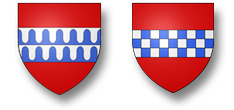 |
From L to R: Arms of Sir William Lindsay of Luffness, 2nd Lord of Crawford, as shown in the later Pinckney-dimidiated-Lindsay seal (1254-1256); and the arms of Sir Alexander (1296), father of Sir David Lindsay, 6th Lord of Crawford. No arms earlier than these are recorded for the Lindsay family.
Alexander's eldest son Sir David succeeded to the Crawford estates by 1308 as Lord of Crawford. He was one of the barons whose seal was appended to the 1320 letter to Pope John XXII asserting the independence of Scotland. He acquired Glenesk in Angus by marriage to the heraldic heiress Maria Abernethy in 1325. The arms of direct descendants of this marriage continue to this day to be quartered Lindsay and Abernethy.
Sir David Lindsay of Glenesk, born in about 1360, succeeded to the Lordship of Lindsay and Barony of Crawford on the death of his cousin James. He took part in a joust with Lord Welles on London Bridge on St George's Day (23 April) in 1390, in the presence of Richard II of England, and won both the day and the admiration of the English King. In 1398 he was created Earl of Crawford.
The fourth earl, Alexander, known as 'The Tiger' rebelled against James II
in 1452 and was defeated at the Battle of Brechin after which he was stripped
of his title. He was later pardoned. 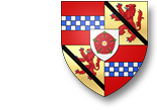 His
son David rose high in royal favour and was successively Lord High Admiral
of Scotland, Master of the Royal Household, Lord Chamberlain from 1483-1488,
and High Justiciary. He was created Duke of Montrose in 1488 but this
title was annulled after the death of James III. The sixth earl, John, died at the Battle of Flodden in 1513.
His
son David rose high in royal favour and was successively Lord High Admiral
of Scotland, Master of the Royal Household, Lord Chamberlain from 1483-1488,
and High Justiciary. He was created Duke of Montrose in 1488 but this
title was annulled after the death of James III. The sixth earl, John, died at the Battle of Flodden in 1513.
The descent of the Earldom of Crawford, which has been transferred at various times between different branches of the family, is a splendid example of the Scottish system of resignation and re-grant. For example, in 1542 David Lindsay of Edzell (who died 1558) succeeded as 9th Earl on the death of his namesake, the 8th Earl who had excluded his own son Alexander (the 'Wicked Master') from the title. David of Edzell re-conveyed the earldom to his cousin David, the son of Alexander, who became the 10th Earl.
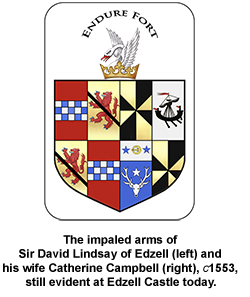 David of Edzell's third son by Catherine Campbell was John, founder of the
Balcarres line of the family. He was a statesman during the reign of King James
VI, and on his appointment to the Court of Session took the judicial title of
Lord Menmuir. David, second son of Lord Menmuir, who had bought the lands of
Balcarres and Pitcorthie in Fife, was created Lord Lindsay of Balcarres in 1633.
His son Alexander was created Lord Lindsay of Balniel and Earl of Balcarres in
1651.
David of Edzell's third son by Catherine Campbell was John, founder of the
Balcarres line of the family. He was a statesman during the reign of King James
VI, and on his appointment to the Court of Session took the judicial title of
Lord Menmuir. David, second son of Lord Menmuir, who had bought the lands of
Balcarres and Pitcorthie in Fife, was created Lord Lindsay of Balcarres in 1633.
His son Alexander was created Lord Lindsay of Balniel and Earl of Balcarres in
1651.
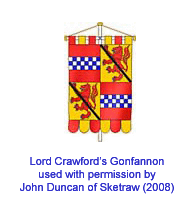 General
Alexander Lindsay, great-grandson of Alexander, became the 6th Earl of Balcarres, and
was always known by that title. In 1808 he became de jure 23rd
Earl of Crawford following the death of his cousin George Lindsay-Crawford.
The 25th Earl of Crawford and 8th Earl of Balcarres, Alexander
William Crawford Lindsay, wrote the four-volume series on the Lives of the
Lindsays, now considered a genealogical standard text. Succeeding Earls
of Crawford and Balcarres have also played important roles in Scottish national history.
General
Alexander Lindsay, great-grandson of Alexander, became the 6th Earl of Balcarres, and
was always known by that title. In 1808 he became de jure 23rd
Earl of Crawford following the death of his cousin George Lindsay-Crawford.
The 25th Earl of Crawford and 8th Earl of Balcarres, Alexander
William Crawford Lindsay, wrote the four-volume series on the Lives of the
Lindsays, now considered a genealogical standard text. Succeeding Earls
of Crawford and Balcarres have also played important roles in Scottish national history.
Our late Chief Robert Lindsay, 29th Earl of Crawford and 12th Earl of Balcarres, served in the Grenadier Guards and then became a Member of Parliament. He was Minister of State for Defence from 1970-1972 and for Foreign and Commonwealth Affairs from 1972-1974. He has been First Crown Estate Commissioner, Chairman of the Ancient and Historic Buildings Council for Scotland and was Lord Chamberlain to HM Queen Elizabeth the Queen Mother. He was installed as a Knight of the Order of the Thistle by HM The Queen in 1997.
 |
The late Lord and Lady Crawford in the Pleasance at Edzell Castle on the occasion of the celebration of the 600th anniversary of the Earldom of Crawford. (Photograph by Marty Thurmond, 1998).
Our Chief is Anthony Robert Lindsay, 30th Earl of Crawford and 13th Earl of Balcarres, the 38th Lord Lindsay of Crawford. He acted as Deputy to the Great Steward of Scotland at the coronation of Charles III in 2023.
Our Chieftain is James Lindesay-Bethune MA, 16th Earl of Lindsay and 25th Lord Lindsay of the Byres. He descends from Sir John Lindsay, who was created Lord Lindsay of the Byres in 1444. The Lindsays of the Mount are a cadet branch of the Byres line. One of the most famous names in Scottish history is that of Sir David Lindsay of the Mount (c. 1486-1555), Lord Lyon King of Arms (1542-1554) and previously Lyon Depute. His Satyre of the Thrie Estaitis, first performed in 1552 is is still staged in the 21st century! His half-nephew Sir David Lindsay of the Mount also held the office of Lord Lyon (1591-1620), as did his son-in-law Sir Jerome Lindsay of Annatland (1620-1630). Sir Jerome had a daughter Rachell who in 1640 married Lt-Col. Bernard Lindsay, a grandson of the Snawdoun Herald and Lyon Depute Thomas Lindesay. The Snawdoun Herald's third son, Robert of Tullyhogue and Loughry, has Lindesay descendants in Australia, New Zealand and the United Kingdom.
All Lindsay of the Byres coats of arms include three stars in chief. To distinguish the various branches descended from younger sons, each displays a different charge (symbol) in base.
 |
From L to R: Arms of Lord Lindsay of the Byres (1390), Nephew to Lord Lindsay (1497), Lindsay of Kirkforthar (c 1500), Lindsay of Eaglescairnie (c 1610), Lindsay of Pyotstone (1600), Lindsay of Wormestone (1672), Lindsay of the Mount (1512), and Lindsay descendants of Garmylton (1561) later of Tullyhogue (1610) later of Loughry (1632). Source of illustrations, except second: Wikimandia, CC BY-SA 4.0
The coat of arms of our chieftain, James Lindesay-Bethune, includes quarterings from the marriage of George Lindsay of Wormestone to the heraldic heiress Margaret Bethune of Balfour in 1721. The arms of the representative descendant of the Lindesays of Loughry includes quarterings from the marriage of Robert Lindesay of Loughry to the heraldic heiress Jane Mauleverer of Arncliffe in 1775.
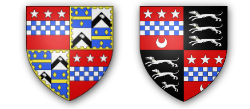 |
From L to R: Arms of the Earl of Lindsay (1918), and of the cadet branch Lindesay of Loughry (1832). Source of L illustration: Wikimandia, CC BY-SA 4.0
There are many branches of the family and some two hundred different spellings of the name. Lord Lindsay, in his book Family of Lindsay (vol 1, p 3) gives eighty-four spellings. Many Lindsays (however spelt) have volunteered to be part of the international Lindsay DNA Project; see the Lindsays International web site for further details.
The arms of our Chief which are contained within the Lyon Register, I, 50; XI, 48 are blazoned (officially described) as follows:
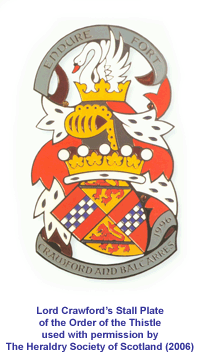 Arms: Quarterly, 1st and 4th Gules a Fess chequy
Argent and Azure (for LINDSAY); 2nd and 3rd Or a Lion
rampant Gules armed and langued Azure debruised with a Ribbon Sable (for
ABERNETHY).
Arms: Quarterly, 1st and 4th Gules a Fess chequy
Argent and Azure (for LINDSAY); 2nd and 3rd Or a Lion
rampant Gules armed and langued Azure debruised with a Ribbon Sable (for
ABERNETHY).
The arms in the first and fourth quarters depict a silver and blue check pattern on a red background, and in the second and third quarters a red rampant lion with blue tongue and claws on a gold field. Over each lion is a thin black stripe.
Crest: From an antique ducal Coronet a demi-Swan Wings addorsed and elevated proper.
The crest features a white swan within a gold antique coronet of fleurs-de-lis, above a helm and coronet of suitable rank.
Supporters: Two Lions rampant guardant Gules armed and langued Azure.
The Motto, Endure Fort, means endure bravely.
A Banner of the late Lord Crawford's arms hung in the Preston Aisle of St Giles' Cathedral, the High Kirk of Edinburgh.
Our Chief does not have a Badge, a Standard or a Pinsel.
These arms are the property of our Chief and may not be used by anyone else. All clan members may, however, use our Crest-Badge, (at the top right of this screen), including those members with surnames that have a territorial or other traditional association with the Lindsay family.
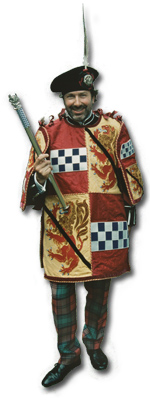 |
The Hon Alexander Lindsay, Endure Pursuivant, at St Andrews, Scotland. (Photograph by Leslie Hodgson, 2006).
The arms are reflected in the design of the tabard worn by Endure Pursuivant, the private officer-of-arms to Lord Crawford. This office, named after Lord Crawford's motto, dates from 1454 (Friar, 1987).
Another private officer-of-arms, Lindsay Herald, was also attached to the Lindsay family and was first mentioned in 1402 (Fox-Davies, 1985; Friar, 1987). This office no longer exists. The 5th Earl, when created Duke of Montrose in 1488, appointed Montrose Pursuivant. This office also no longer exists.
(Notes on pronunciation: Balcarres is pronounced Bal-car-riss; Bethune is pronounced Bee-ton).
Translate this page using Google Translate